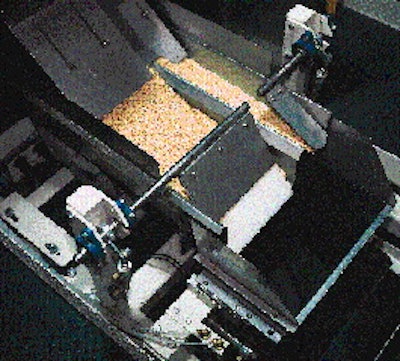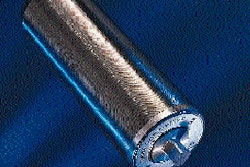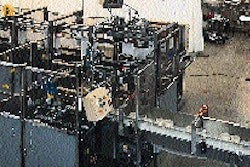What began as a trickle of automation has turned into a flood at Blue Diamond Growers cooperative in Sacramento, CA. Last summer the nation's leading almond producer put the finishing touches on a sophisticated empty case-handling and filling system in its bulk packing area, where 1겨-lb bins and 25- and 50-lb corrugated cases are packed for food processors that use almonds as ingredients. Making the transformation even more dramatic, says project engineer Darrell Nelson, is that as recently as 1993, Blue Diamond didn't even have an automatic scale in its bulk packaging operation. Once an automatic net weigh filler was installed on a trial basis and Blue Diamond saw how much could be saved by reducing giveaway, additional investments followed. A second net weigh filler was added in 1994, as well as a case erector and plastic liner inserter. After Blue Diamond completed a facility study that determined the firm would maintain its production operations in the Sacramento plant, a modernization and automation program was begun. Last summer three more Temco (Benicia, CA) net weigh fillers were added along with a conveyor system to move almonds from processing to packaging. Downstream, a random-height case taper from Marq (Yakima, WA) does the work formerly performed by as many as five people. Among the more intriguing things about the five net weigh fillers now running at Blue Diamond is how each can be used to fill either corrugated cases or bins that hold 1겨 lb. One key to this flexibility is that both empty- and full-case conveying is done overhead. Cases ride a declining conveyor section to get to floor level where the fillers are located. When Blue Diamond needs to run bulk totes at a particular filler, the declining conveyor is lifted out of the way by an overhead hoist on one end and a pivoting connection at the other. That makes room for entrance and exit of fork lifts carrying the bulk bins on pallets. Equally important is that the floor-level conveyor sections carrying cases beneath the five product discharge chutes are all portable. Like the decline conveyor, they are easily disengaged and wheeled out of the way when bulk totes need to be positioned beneath the scales. Conveying's the key Conveyor connections, installed last summer by Sierra Conveyor (Rocklin, CA) are certainly a key to making the whole system click. For the most part it's a line shaft-driven roller conveyor that receives lined cases from the liner inserter at floor level and takes them up an incline to a "fork in the road" at the overhead level. Here the 25-lb small cases are diverted to one track and the larger cases that hold 50 lb to another that runs right beside it. About 30 feet after this split, the two parallel overhead conveyors both make a right angle turn in the direction of the five weigh scales some 150' away. This puts the 50-lb cases on an "inside" track relative to the weigh scales and the 25-lb cases on an "outside" track. Both cases have the same footprint; only heights vary. The operator at the case erector loads 50 or so small case blanks into the magazine and then the same number of the larger size. The operator alternates in this fashion, each time triggering a switch on the control panel that redirects the gate for the appropriate roller conveyor. The system makes it possible to have up to 40 minutes of each case size queued up on the overhead tracks. Down to the fillers It's when cases draw near the five net weigh fillers that things really get interesting. Based on signals sent by the fillers, cases either bypass a filler or move into position beneath one. For instance, suppose weigh scale #3 carries slivered almonds, it's programmed to fill 25-lb cases, and it's in need of a fresh case. It sends a signal to the overhead accumulation system that releases a case forward. The case bypasses the conveyors leading to scales #1 and #2. But as it draws even with #3, a belt transfer device rises between the rollers in the roller conveyor and propels the case at a right angle onto a second belt transfer that carries it across the conveyor carrying larger cases. A belt conveyor then takes the case down to floor level for filling. At all five fillers product flows from surge hopper to infeed hopper to vibratory feeders and finally into the weigh bucket. When the load cell in the weigh bucket detects the proper weight, product flow is cut off, a chute opens and the weighed almonds drop into the waiting lined case below. "The scales are very accurate," says Nelson. "We've virtually eliminated giveaway." Case movement at floor level is equally automated. Sensors detect case position and relay that information to a PLC whose application software "tells" actuators to hold a case, release it forward, stop it accurately beneath the discharge chute, and finally release it toward the case elevator that takes it back to the overhead level for case taping. The final piece of equipment in the filling portion of the line is back up at the overhead level. It's a Marq random-height case taper monitored by one operator whose main responsibility is to "uncuff" the cases by folding the plastic liners inside. The taping machine folds flaps before taping. Taped cases then move toward the palletizing operation (see PW, May '96, p. 23). On the day PW toured Blue Diamond, only two of the five net weigh fillers were filling cases because one was undergoing scheduled maintenance and two were filling bulk bins. Even so, the flow of cases and the amount of automated control over them was impressive. According to plant supervisor Don King, it's when all five fillers are producing cases that the system is most intriguing to watch. "That's when the system needs to hit on all cylinders," he says. Then he adds, "And it does."























